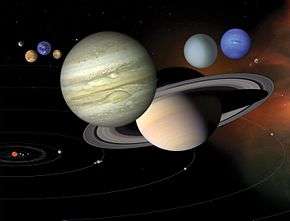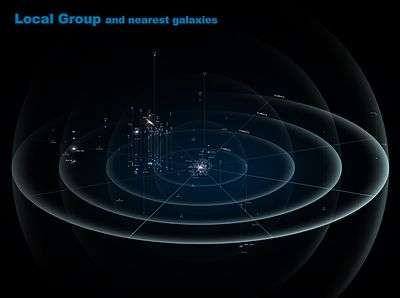Outline of Earth
The following outline is provided as an overview of and topical guide to the planet Earth:
Earth – third planet from the Sun, the densest planet in the Solar System, the largest of the Solar System's four terrestrial planets, and the only astronomical object known to harbor life.
Classification of Earth
Location of Earth
Earth's location in the Universe
- Universe – all of time and space and its contents.
- Observable universe – spherical region of the Universe comprising all matter that may be observed from Earth at the present time, because light and other signals from these objects have had time to reach Earth since the beginning of the cosmological expansion.
- Laniakea Supercluster – galaxy supercluster that is home to the Milky Way and approximately 100,000 other nearby galaxies. Includes the prior defined local supercluster, the Virgo Supercluster, as an appendage.
- Virgo Supercluster – one of the approximately 10 million superclusters in the observable universe. It spans 33 megaparsecs (110 million light-years), and contains at least 100 galaxy groups and clusters, including the Local Group.
- Local Group – specific galaxy group that includes the Milky Way and at least 53 other galaxies, most of them dwarf galaxies.
- Milky Way Galaxy – a specific barred spiral galaxy
- Orion Arm – a spiral arm of the Milky Way
- Solar System – the Sun and the objects that orbit it, including 8 planets, the 3rd planet closest to the Sun being Earth
- Earth's orbit – path through which the Earth travels around the Sun. The average distance between the Earth and the Sun is 149.60 million kilometers (92.96 million miles).[1]
- Solar System – the Sun and the objects that orbit it, including 8 planets, the 3rd planet closest to the Sun being Earth
- Orion Arm – a spiral arm of the Milky Way
- Milky Way Galaxy – a specific barred spiral galaxy
- Local Group – specific galaxy group that includes the Milky Way and at least 53 other galaxies, most of them dwarf galaxies.
- Virgo Supercluster – one of the approximately 10 million superclusters in the observable universe. It spans 33 megaparsecs (110 million light-years), and contains at least 100 galaxy groups and clusters, including the Local Group.
- Laniakea Supercluster – galaxy supercluster that is home to the Milky Way and approximately 100,000 other nearby galaxies. Includes the prior defined local supercluster, the Virgo Supercluster, as an appendage.
- Observable universe – spherical region of the Universe comprising all matter that may be observed from Earth at the present time, because light and other signals from these objects have had time to reach Earth since the beginning of the cosmological expansion.
Movement of the Earth
Features of Earth
- Age of the Earth
- Figure of the Earth (size and shape)
- Earth radius
- Models of the Earth
Earth's spheres
Earth's biosphere
Earth's geosphere
- Structure of the Earth
- Earth's surface
- Lithosphere of Earth (solid Earth)
- Earth's crust
- Land
- Landforms (list)
- Continents
- Africa
- Antarctica
- Asia
- Australia
- Europe
- North America
- South America
- Pedosphere
- Ocean floor
- Earth's mantle
- Earth's core
- Outer core
- Inner core
Earth's hydrosphere
This sphere represents all water on Earth, wherever it is and in whatever form within the water cycle.
- Water, by relative altitude
Atmospheric water
Cryosphere (frozen water)
Surface water
- Bodies of water (list)
- World Ocean
- Southern Ocean
- Oceans - This includes the Earth's 5 oceans: The Arctic Ocean, the Atlantic Ocean, the Indian Ocean, and the Pacific Ocean.
- Groundwater
Water, by salt content
Astronomical events on Earth
- Meteor showers (list)
- Meteorite falls
- Tides
- Eclipse - This includes both a lunar eclipse and solar eclipse.
- Equinox - This includes both the March equinox and the September equinox.
- Solstice - This includes the Summer solstice, June solstice, Winter solstice, and December solstice
- Manhattanhenge
Natural satellites of Earth
History of Earth
Future of Earth
- Climate change
- Global catastrophic risk
gollark: You need a complex runtime which also has an interpreter.
gollark: oh, I like that.
gollark: I was thinking λ and something to do with lambda calculus.
gollark: Anyone got ideas for fun new commands?
gollark: I misread it when I was writing it, apparently.
See also
- Earth and atmospheric sciences journals
- Earth phase
- Earth sciences
- List of fields of science that study the Earth
- Geoscience organizations
- List of environmental organizations
- Outline of the Solar System
- World
References
- "Sun: Facts & Figures". Solar System Exploration. National Aeronautics and Space Administration. Archived from the original on July 3, 2015. Retrieved July 29, 2015.
External links
- National Geographic encyclopedic entry about Earth
- Earth – Profile – Solar System Exploration – NASA
- Earth – Climate Changes Cause Shape to Change – NASA
- United States Geological Survey – USGS
- Earth – Astronaut Photography Gateway – NASA
- Earth Observatory – NASA
- Earth – Audio (29:28) – Cain/Gay – Astronomy Cast (2007)
- Earth – Videos – International Space Station:
- Video (01:02) – Earth (time-lapse)
- Video (00:27) – Earth and Auroras (time-lapse)
This article is issued from Wikipedia. The text is licensed under Creative Commons - Attribution - Sharealike. Additional terms may apply for the media files.




.jpg)



